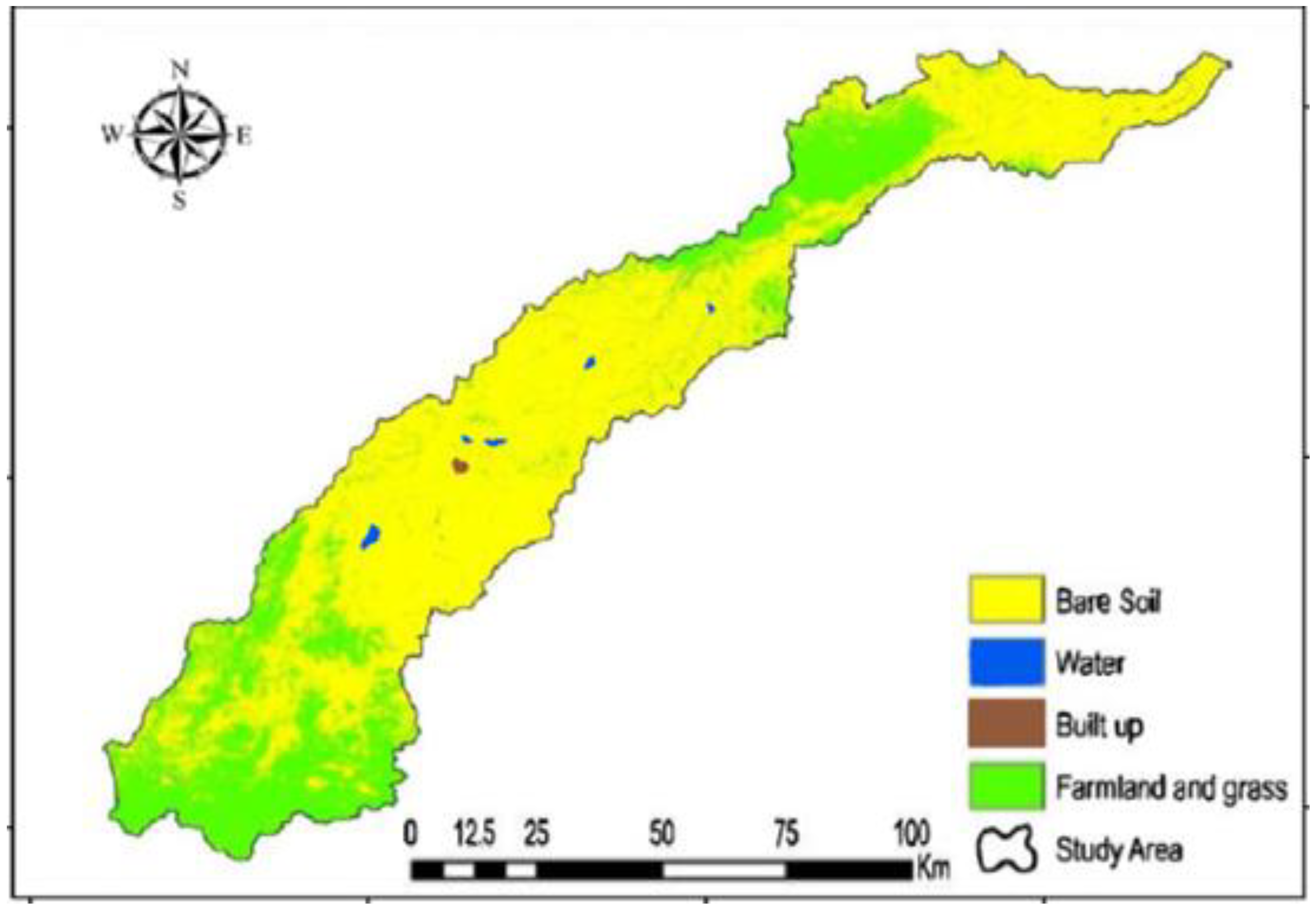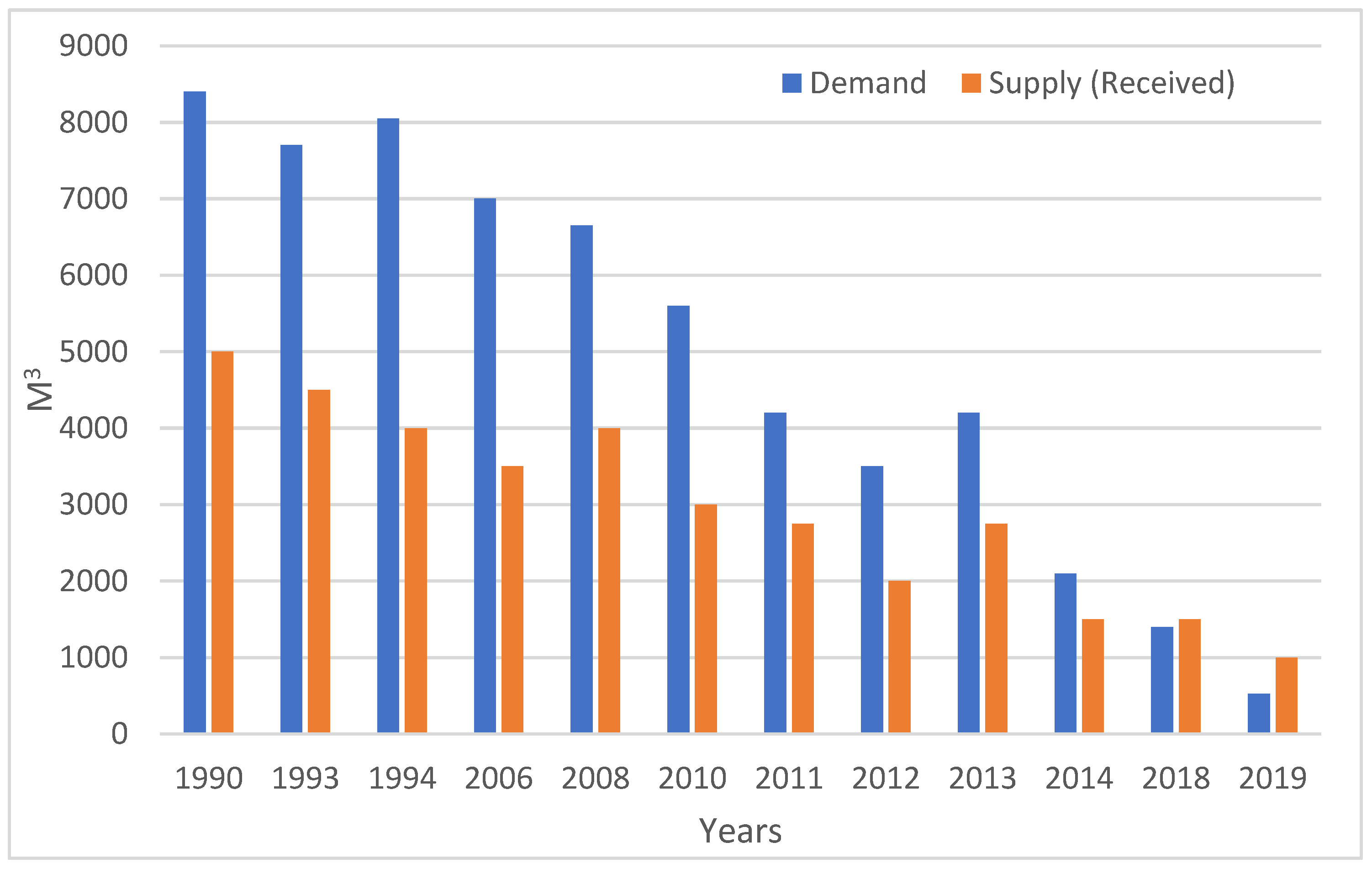Sustainability of the Al-Abila Dam in the Western Desert of Iraq
Abstract
:1. Introduction
2. Materials and Methods
2.1. Study Area
2.2. Catchment Characteristics
2.3. Physical Characteristics
2.4. Water Balance Model
2.5. Assessing the Sustainability of the Al-Abila Dam
2.5.1. Reliability of Water Supply and Potential
2.5.2. Effectiveness of Water Use
3. Results and Discussions
3.1. Land Use/Cover (LU/LC)
3.2. Rainwater Harvesting Characteristics
3.3. Assessing the Sustainability of the Al-Abila Dam
3.3.1. Reliability of the Water Supply and Potential
3.3.2. Effectiveness of Water Use
Constraints
- After examining the design structure maps and conducting field observations, we discovered that there is no bottom outlet utilized to operate the dam in order to deliver water for irrigation.
- We detected seepage along the dam’s body based on prior studies and field interviews with engineering supervisors.
- Unlined irrigation canals cause a lot of water loss, erosion, and sedimentation.
- The assessment of water projects in Iraq’s Western Desert confirmed that the Western Desert’s water resources are poorly managed. A huge volume of water flows into the river without being used in the Wadies upstream.
- The Iraqi Western Desert, like all arid and semi-arid regions, suffers from a lack of data, particularly for surface runoff in valleys.
- Bedouins and those who live near water harvesting systems face a lack of assistance. People are still using simple ways to convey and use water.
Suggestions and Recommendations
- Maintain and control losses by lining the canals and grouting the concrete along the body of the dam.
- We propose installing hydrometric stations at the valley outlets in order to obtain accurate surface runoff data.
- We urge additional researchers to conduct field studies and field observations at small dam sites to develop a better understanding of all the data needed to construct and maintain dams in the Western Desert.
- Organize seminars and meetings with Bedouins and local farmers to apply modern technology and smart agriculture to this region, resulting in the best possible use of dam irrigation systems to support local livelihoods.
4. Conclusions
Author Contributions
Funding
Institutional Review Board Statement
Informed Consent Statement
Data Availability Statement
Acknowledgments
Conflicts of Interest
References
- Wesseling, J.; Adham, A.; Riksen, M.; Ritsema, C.; Oostindie, K.; Heidema, N. A Microsoft Excel Application to Simulate Water Harvesting in a Catchment. Water Harvest. Res. 2021, 4, 1–18. [Google Scholar]
- Sayl, K.N.; Mohammed, A.S.; Ahmed, A.D. GIS-based approach for rainwater harvesting site selection. IOP Conf. Ser. Mater. Sci. Eng. 2020, 737, 012246. [Google Scholar] [CrossRef]
- Hussien, B.M. Hydrogeologic condition within al-Anbar governorate. J. Anbar Univ. Pure Sci. 2010, 4, 97–111. [Google Scholar]
- Kamel, A.; Sulaiman, S.O.; Sayl, K.N. Hydrologic study for the Iraqi Western Desert to assess water harvesting projects. Iraqi J. Civ. Eng. 2011, 7, 16–27. [Google Scholar]
- Dongol, R.; Bohora, R.C.; Chalise, S.R. Sustainability of rainwater harvesting system for the domestic needs: A case of Daugha Village Development Committee, Gulmi, Nepal. Nepal J. Environ. Sci. 2017, 5, 19–25. [Google Scholar] [CrossRef] [Green Version]
- Pope, J.; Annandale, D.; A Morrison-Saunders, A. Conceptualising sustainability assessment. Environ. Impact Assess Rev. 2004, 24, 595–616. [Google Scholar] [CrossRef] [Green Version]
- Waheed, B.; Khan, F.; Veitch, B. Linkage-Based Frameworks for Sustainability Assessment: Making a Case for Driving Force-Pressure-State-Exposure- Effect-Action (DPSEEA) Frameworks. Sustainability 2009, 1, 441–463. [Google Scholar] [CrossRef] [Green Version]
- Pachpute, J.S.; Tumbo, S.D.; Sally, H.; Mul, M.L. Sustainability of rainwater harvesting systems in rural catchment of Sub-Saharan Africa. Water Resour. Manag. 2009, 23, 2815–2839. [Google Scholar] [CrossRef]
- Ngigi, S.; Savenije, H.H.G.; Glehuki, F.N. Hydrological impacts of flood storage and management on irrigation water abstraction in Upper Ewaso Ng’iro river basin, Kenya. J. Water Resour. Manag. 2008, 22, 1859–1879. [Google Scholar] [CrossRef] [Green Version]
- Hashimoto, T.; Stedinger, J.R.; Loucks, D.P. Reliability, resiliency, and vulnerability criteria for water resource system performance evaluation. Water Resour. Res. 1982, 18, 14–20. [Google Scholar] [CrossRef] [Green Version]
- Kjeldsen, T.R.; Rosbjerg, D. Choice of reliability, resilience and vulnerability estimators for risk assessments of water resources systems. Hydrol. Sci. J. 2004, 49, 755–767. [Google Scholar] [CrossRef]
- Sandoval-Solis, S.; McKinney, D.C.; Loucks, D.P. Sustainability index for water resources planning and management. J. Water Resour. Plan. Manag. 2011, 137, 381–390. [Google Scholar] [CrossRef] [Green Version]
- Park, D.; Um, M.-J. Sustainability Index Evaluation of the Rainwater Harvesting System in Six US Urban Cities Daeryong. Sustainability 2018, 10, 280. [Google Scholar] [CrossRef] [Green Version]
- Sulaiman, S.O.; Kamel, A.H.; Sayl, K.N.; Alfadhel, M.Y. Water resources management and sustainability over the Western desert of Iraq. Environ. Earth Sci. 2019, 78, 495. [Google Scholar] [CrossRef]
- Abdulhameeda, I.M.; Mohammeda, A.S.; Kamela, A.H.; ALmafrchib, K.Y.; Alhadeethia, I.K.; Fayyadha, A.S.; Al-Esawia, J.S.E. Sustainable Development of Wadi Houran-Western Iraqi Desert. Iraqi J. Civ. Eng. 2020, 15, 45–53. [Google Scholar]
- Sayl, K.; Adham, A.; Ritsema, C.J. A GIS-based multicriteria analysis in modeling optimum sites for rainwater harvesting. Hydrology 2020, 7, 51. [Google Scholar] [CrossRef]
- Adham, A.; Sayl, K.N.; Abed, R.; Abdeladhim, M.A.; Wesseling, J.G.; Riksen, M.; Ritsema, C.J. A GIS-based approach for identifying potential sites for harvesting rainwater in the Western Desert of Iraq. Int. Soil Water Conserv. Res. 2018, 6, 297–304. [Google Scholar] [CrossRef]
- Consortium-Yugoslavia. Hydrogeological Explorations and Hydrotechnical Work-Western Desert of Iraq; Blook7; Directorate of Western Desert Development Projects: Baghdad, Iraq, 1977; Unpublished. [Google Scholar]
- Ministry of Water Resources. General Authority for Dams and Reservoirs; Water Resources Department in Al-Anbar Governorate: Baghdad, Iraq, 2015; Unpublished data.
- Ministry of Agriculture. Hydrological Explorations and Hydro Technical Works. (Vol 1 Climatology and Hydrology Works); Vol 5: Hydrology Iraq Western Desert—Block 7; Directorate of Western Desert Development Projects: Baghdad, Iraq, 1977.
- Adham, A.; Wesseling, J.G.; Abed, R.; Riksen, M.; Ouessar, M.; Ritsema, C.J. Assessing the impact of climate change on rainwater harvesting in the Oum Zessar watershed in Southeastern Tunisia. Agric. Water Manag. 2019, 221, 131–140. [Google Scholar] [CrossRef]
- Boers, T.M.; Zondervan, K.; Ben-Asher, J. Micro-catchment-water-harvesting (MCWH) for arid zone development. Agric. Water Manag. 1986, 12, 21–39. [Google Scholar] [CrossRef]
- Charman, J.; Kostov, L.; Minetti, J.; Stoutesdijk, D.; Tricoli, D.; Olivier, A. Small Dams and Weirs in Earth and Gabion Materials; Land and Water Development Division, Food and Agriculture Organization of the United Nations: Rome, Italy, 2001. [Google Scholar]
- Maestre-Valero, J.F.; Martínez-Granados, D.; Martínez-Alvarez, V.; Calatrava, J. Socio-economic impact of evaporation losses from reservoirs under past, current and future water availability scenarios in the semi-arid Segura Basin. Water Resour. Manag. 2013, 27, 1411–1426. [Google Scholar] [CrossRef]
- Martinez-Granados, D.; Francisco Maestre-Valero, J.; Calatrava, J.; Martinez-Alvarez, V. The economic impact of water evaporation losses from water reservoirs in the Segura Basin, SE Spain. Water Resour. Manag. 2011, 25, 3153–3175. [Google Scholar] [CrossRef]
- Gallego-Elvira, B.; Martínez-Alvarez, V.; Pittaway, P.; Brink, G.; Martín-Gorriz, B. Impact of micrometeorological conditions on the efficiency of artificial monolayers in reducing evaporation. Water Resour. Manag. 2013, 27, 2251–2266. [Google Scholar] [CrossRef]
- Laxman, J. An Artificial Neural Network Approach for the Determination of Infiltration Model Parameters. Ph.D. Thesis, Dept. Faculty of Engineering, Swami Ramanand Teerth Marathwada University, Nanded, India, 2016. [Google Scholar]
- Western Desert Dams, Design Report of Horan Dam H/3, H/2; Ministry of Irrigation: Colombo, Sri Lanka, 1994.
- Yuan, Y.; Mitchell, J.; Hirschi, M.; Cooke, R. Modified SCS curve number method for predicting subsurface drainage flow. Trans. ASBE 2001, 44, 1673–1682. [Google Scholar] [CrossRef]
- Sayl, K.N.; Afan, H.A.; Muhamad, N.S.; Elshafie, A. Development of a Spatial Hydrologic Soil Map Using Spectral Reflecatance Band Recognition and a Multiple-Output Artificial Neural Network Model. Hydrol. Earth Syst. Sci. Discuss 2017, 1–16. [Google Scholar] [CrossRef]






| Name of Dam | Catchment Area (km2) | Storage Area (km2) | Max. Spillway Height (m) | Storage Capacity (m3) |
|---|---|---|---|---|
| Al-Abila dam | 580 | 1.5 | 11 | 310,142 |
| Hydrologic Soil Group (HSG) | ||||
|---|---|---|---|---|
| Land Cover | A | B | C | T |
| Bare Soil | 77 | 86 | 91 | 94 |
| Built up | 61 | 75 | 83 | 87 |
| Water | 100 | 100 | 100 | 100 |
| Farmland | 72 | 81 | 88 | 91 |
| Grass | 43 | 65 | 76 | 82 |
| Average Slope (m/km) | Main Soil Type | Significant LU/LC | Water Availability | Catchment Area (km2) | CN | Max. Retention (S) |
|---|---|---|---|---|---|---|
| 1.46 | Sandy loam | Bare land | Ephemeral | 580 | 76.5 | 78.2 |
| Month | Human Uses (m3) ×103 | Animal Watering (m3) ×103 | Residual Water (m3) ×103 |
|---|---|---|---|
| May | 4 | 23 | 0.3 |
| June | 12 | 64 | 0.1 |
| July | 8 | 41 | 0 |
| August | 0 | 0 | 0 |
| September | 0 | 0 | 0 |
| Total | 24 | 128 |
| Year | Volume of Water Diverting (m3) | Volume of Water Receiving (m3) | Water Conveyance |
|---|---|---|---|
| 1990 | 15,000 | 5000 | 0.33 |
| 1993 | 13,000 | 4500 | 0.35 |
| 1994 | 14,500 | 4000 | 0.28 |
| 2006 | 12,000 | 3500 | 0.29 |
| 2008 | 11,000 | 4000 | 0.36 |
| 2010 | 10,000 | 3000 | 0.3 |
| 2011 | 8500 | 2750 | 0.32 |
| 2012 | 7800 | 2000 | 0.26 |
| 2013 | 9000 | 2750 | 0.31 |
| 2014 | 6000 | 1500 | 0.25 |
| 2018 | 5500 | 1500 | 0.27 |
| 2019 | 4500 | 1000 | 0.22 |
| Average | 0.3 |
Publisher’s Note: MDPI stays neutral with regard to jurisdictional claims in published maps and institutional affiliations. |
© 2022 by the authors. Licensee MDPI, Basel, Switzerland. This article is an open access article distributed under the terms and conditions of the Creative Commons Attribution (CC BY) license (https://creativecommons.org/licenses/by/4.0/).
Share and Cite
Adham, A.; Seeyan, S.; Abed, R.; Mahdi, K.; Riksen, M.; Ritsema, C. Sustainability of the Al-Abila Dam in the Western Desert of Iraq. Water 2022, 14, 586. https://doi.org/10.3390/w14040586
Adham A, Seeyan S, Abed R, Mahdi K, Riksen M, Ritsema C. Sustainability of the Al-Abila Dam in the Western Desert of Iraq. Water. 2022; 14(4):586. https://doi.org/10.3390/w14040586
Chicago/Turabian StyleAdham, Ammar, Shwan Seeyan, Rasha Abed, Karrar Mahdi, Michel Riksen, and Coen Ritsema. 2022. "Sustainability of the Al-Abila Dam in the Western Desert of Iraq" Water 14, no. 4: 586. https://doi.org/10.3390/w14040586
APA StyleAdham, A., Seeyan, S., Abed, R., Mahdi, K., Riksen, M., & Ritsema, C. (2022). Sustainability of the Al-Abila Dam in the Western Desert of Iraq. Water, 14(4), 586. https://doi.org/10.3390/w14040586










